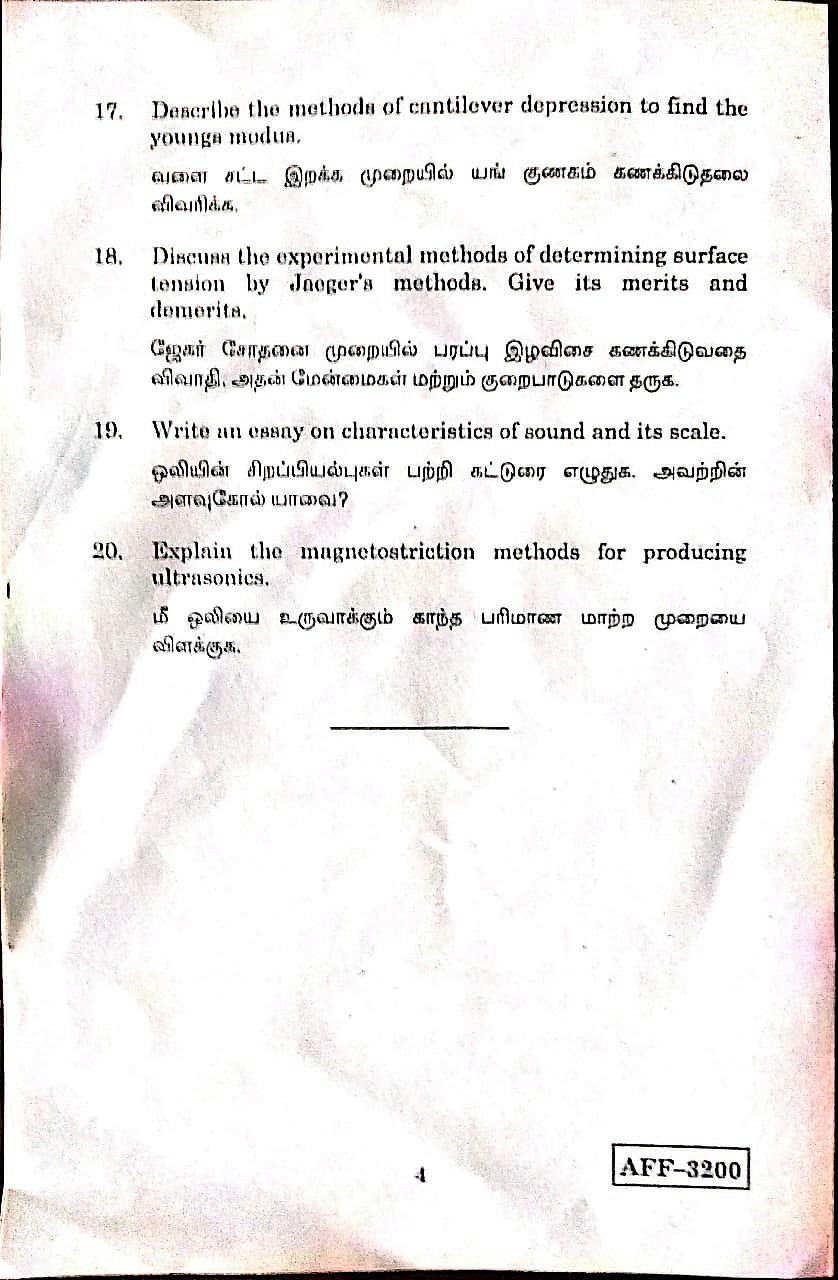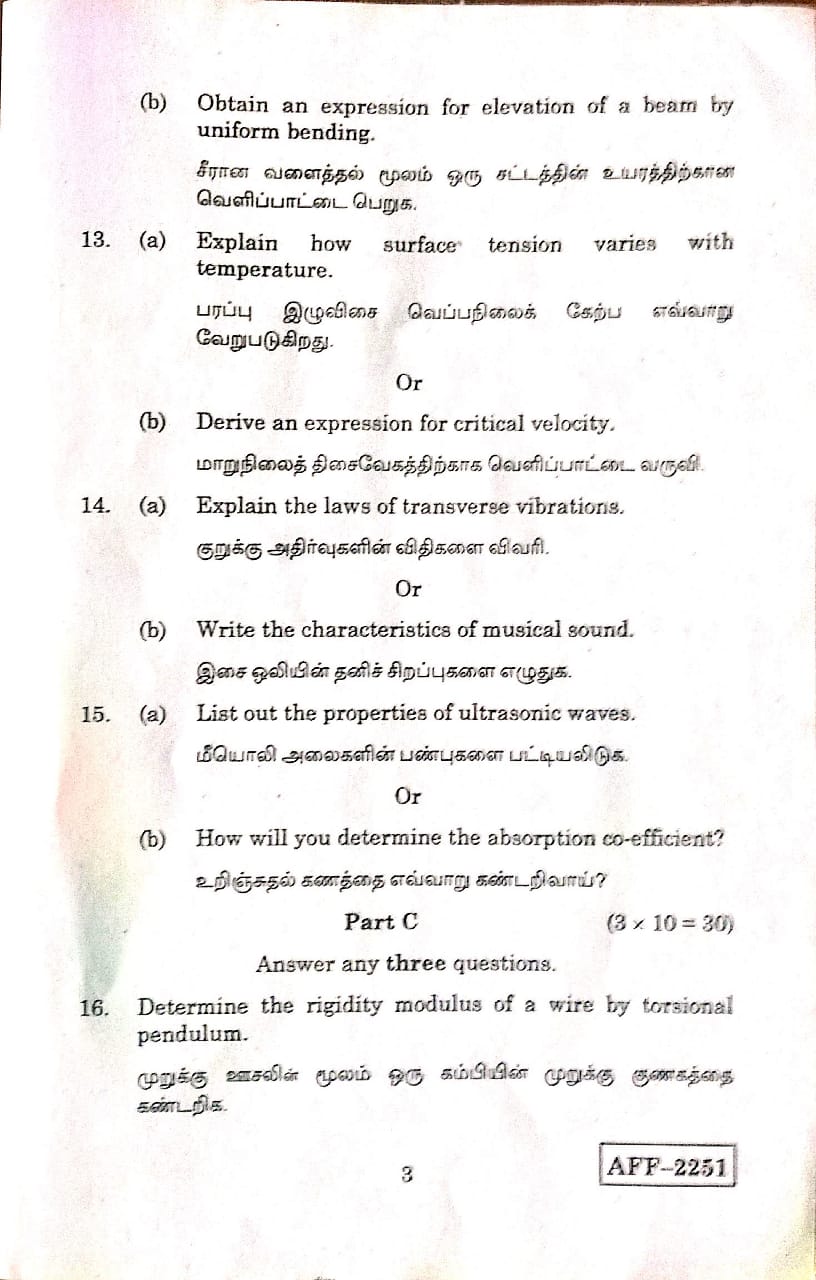OPTICS AND SPECTROSCOPY- 4BPH3C1
PART – A
1. Distinguish between Ramsden eyepiece and Huygens eyepiece.
2. Write short note on chromatic aberration in lenses.
3. Give three methods of minimizing spherical aberration.
4. Define dispersive power of a prism.
5. What is an achromatic doublet?
6. How chromatic aberration is minimized in the case of Huygens and Ramsden eyepieces.
7. Explain briefly about coma.
8. Explain the construction of Ramsden eyepiece with a suitable diagram.
9. Explain the construction of Huygens eyepiece with a suitable diagram.
10. What is an air wedge? State its uses.
11. Give the principle of Jamin interferometer.
12. State Stoke’s law.
13. Explain appearance of colors in thin films.
14. State the uses of Michelson interferometer.
15. Define resolving power .state Rayleigh criterion for resolution.
16. Define resolving power of a grating.
17. Define specific rotation or specific rotatory power.
18. What is a quarter wave plate?
19. What is a half wave plate?
20. What is the difference between unpolarized light and polarized light?
20. Write short notes on quarter wave plate.
21. Write short notes on half wave plate.
22. State and explain Malus law.
23. Write a note on FTIR.
24. Define Spectroscopy.
25. What is Anti-Stokes line?
26.Give the Application of vibrational Raman spectra.
27. What is a selection rule?
28.Expand FTIR.
PART – B
1. Derive the condition for minimization of spherical aberration when two thin lenses are separated by a distance.
2. What is an achromatic doublet? Explain in detail.
3. Explain the working of Huygens eyepiece.
4. Write note on Ramsden eyepiece.
5. Explain the construction and working of a direct vision spectroscope.
6. Describe the effect of interference in reflected light from thin films.
7. Explain how colors appear in thin films due to interference.
8. Describe the experiment to find diameter of a thin wire by air wedge method.
9. Explain the principle and working of Jamin interferometer for determining the refractive index of gas.
10. Explain how Jamin interferometer is used to study the refractive index of a gas at different pressures.
11. Distinguish between Fresnel diffraction and Fraunhofer diffraction.
12. Show that the radii of half period zones are in the ratio of square roots of natural numbers.
13. Explain Fresnel diffraction of light at a circular aperture.
14. Explain Fraunhofer diffraction of light at a single slit.
15. Discuss the Fraunhofer diffraction pattern due to a single slit.
16. Derive an expression for the resolving power of a grating.
17 .Give the Huygens explanation of double refraction in a uni-axial crystal.
18. Give the theory of half wave plate.
19. Give the theory of quarter wave plate.
20. Write note on Microwave and Raman spectroscopy.
21. Explain classical theory of Raman effect.
22. Explain vibrational Raman spectra.
23. Discuss Rotational spectra of diatomic molecules. Give its selection rule.
25. Explain Microwave and Infrared spectroscopy.
26. Explain pure rotational Raman spectrum of linear molecules.
PART – C
1. Define angular dispersion and dispersive power. Derive the conditions to produce (i) dispersion without deviation and (ii) deviation without dispersion in combination of prisms.
2. Derive the condition for achromatism in lenses (i) When they are in contact (ii) When they are separated by a distance ‘a’.
3. What is meant by spherical aberration in lenses? What are the ways to remove spherical aberration?
4. Explain the construction, action and working of a Ramsden eyepiece and Huygens eye piece with neat diagrams. Indicate in a diagram the position of cardinal points for these two eyepieces. How are the chromatic and spherical aberration minimized in these eyepieces?
5. Describe with necessary theory the Newton’s ring experiment for the determination of refractive index of a liquid.
6. Explain the working of Michelson interferometer. How the wavelength of monochromatic light can be measured?
7. Derive the expression for the radius of m
th ring formed in Newton’s ring experiment and hence determine the refractive index of a liquid.
8. Describe Michelson interferometer and explain the formation of fringes in it. How was the instrument used for the standardization of meter?
9. Explain with theory how the wavelength of the light can be determined using diffraction grating by oblique incidence method.
10. Give the theory of plane transmission grating. Describe an experiment to determine the wavelength of sodium light.
11. Define specific rotation and explain Fresnel theory of optical rotation.
12. Describe Laurent’s half shade polarimeter and explain how specific rotary power is determined.
13. Explain the production and the analysis of circularly and elliptically polarized light.
14. Explain how elliptically and circularly polarized light can be produced and analyzed.
15. Explain the production and detection of plane, circularly and elliptically polarized light.
16. Give the theory of production of circularly and elliptically polarized light.
17. Explain Quantum theory of Raman effect.












































